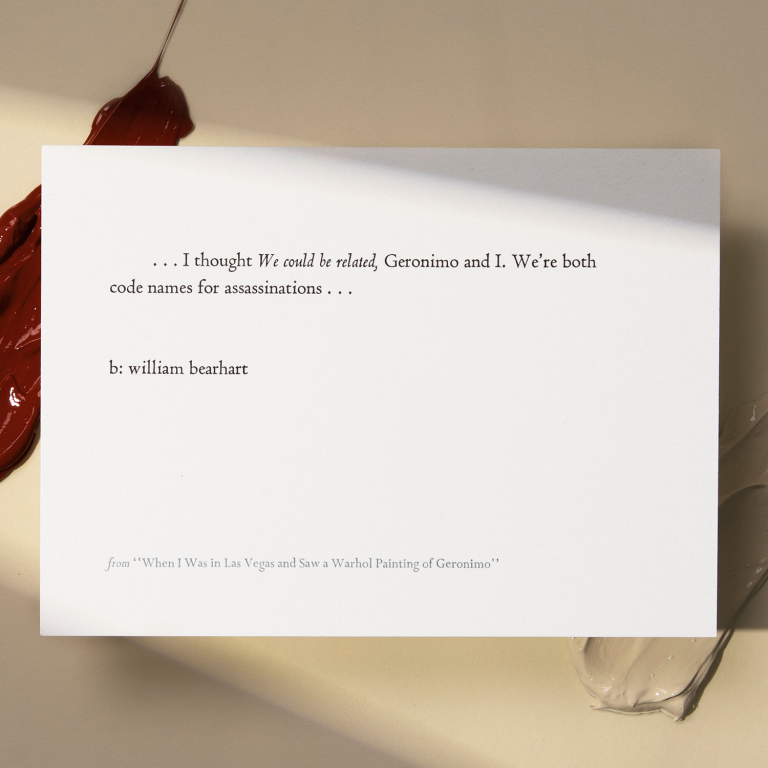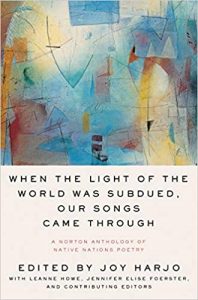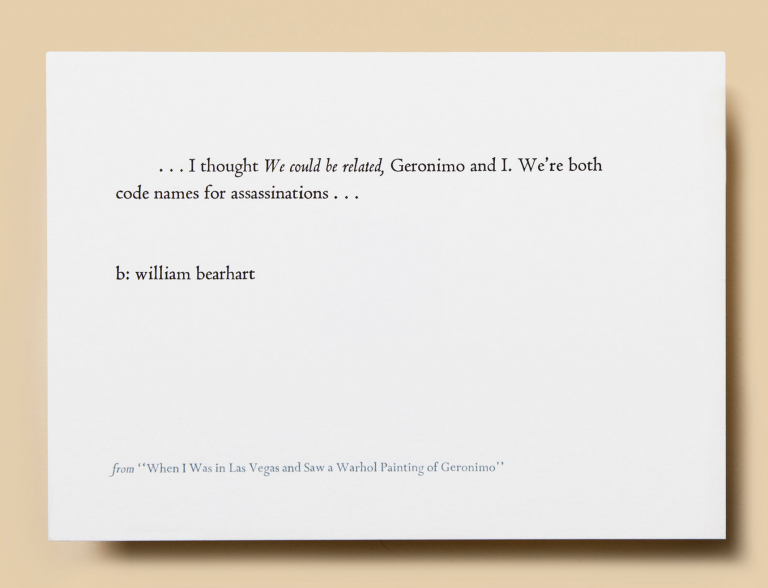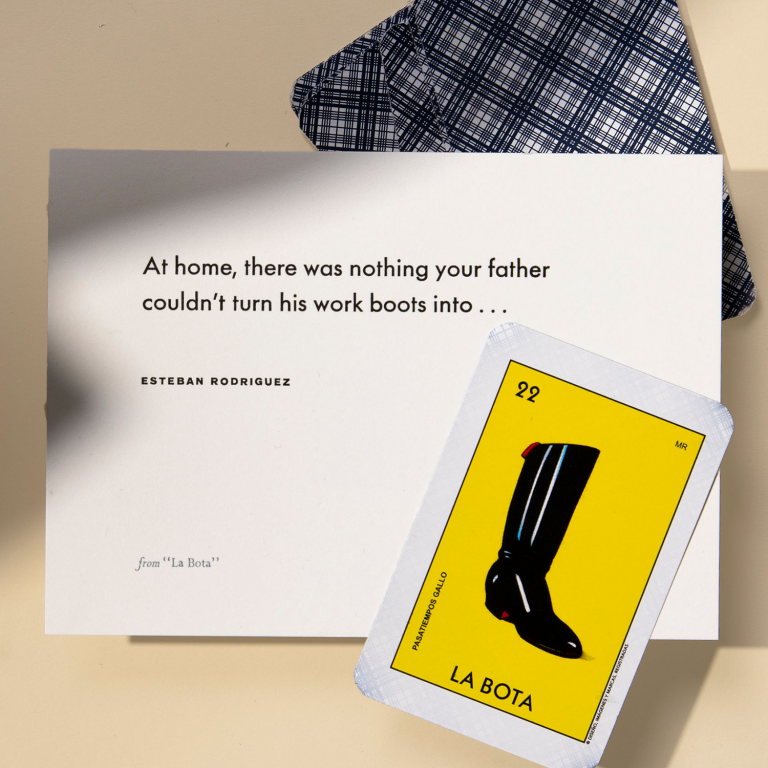b: william bearhart
When I Was in Las Vegas and Saw a Warhol Painting of Geronimo
When looking at Andy Warhol’s painting of Geronimo — a leader and medicine man of the Bedonkohe band of the Apache tribe — b: william bearheart wonders who the Geronimo of the painting is looking back at, and who is looking at it. In many ways, this poem reflects on how this piece of art depicting an Indigenous American was painted by a White person for White people. However, the poet finds connections — of pain, occupation and experience — between himself and Geronimo; and the poem challenges the centrality of the White european gaze.

Letterpress prints by Myrna Keliher | Photography by Lucero Torres © All Rights Reserved.
Guest

b: william bearhart is a direct descendent of the St. Croix Chippewa Indians of Wisconsin. A graduate of the Lo-Rez MFA program at the Institute of American Indian Arts, bearhart’s work appeared in numerous journals and anthologies, including When the Light of the World was Subdued, Our Songs Came Through (W. W. Norton, 2020). His work can be found in Bloom, North American Review, Plume, Prairie Schooner, and Tupelo Quarterly, among others. bearhart worked as a poker dealer in a small Wisconsin casino. He died in August, 2020.
Transcript
Pádraig Ó Tuama: My name is Pádraig Ó Tuama, and one of the things that’s so intriguing about poetry is that often poetry is written in the first person; somebody is speaking, “I this; I that.” You’re voicing words that they’ve written, but it’s not your own words. So a space is brought into play between the voice of the poem and the voice of the person who is reading the poem out. And especially when that space is wide, part of the art of the poem is to step into that space and to allow that space to challenge you. What is the space between me and the speaker of this poem? What are the ways within which our lives are nothing alike? But they’re allowing me, by reading the poem out, to read the poem out in the first person, in order for me to use the imagination to map out the space of power and challenge between me and them.
[music: “Praise the Rain” by Gautam Srikishan]
“When I Was In Las Vegas And Saw A Warhol Painting Of Geronimo” by b: william bearhart:
“When I Was In Las Vegas And Saw A Warhol Painting Of Geronimo”
“I thought We could be related, Andy and I. We’re both
blue walls and yellow cows in a gallery of pristine white. We’re both
screen prints, off-set and layered. Under exposed. We’re both
silver clouds filled with helium and polluted rain. We’re both
white and blonde and scared of hospitals. Only I’m not really any of those things.
And then I thought We could be related, Geronimo and I. We’re both
code names for assassinations. We’re both first
names you yell when you jump from a plane. We’re both
gamblers and dead and neon acrylic brush strokes on a screen printed image. Only I’m more
like a neon beer sign sputtering in a tavern window: burned out, broke,
a heart with arrhythmic beats.”
[music: “Flor Vjell” by Blue Dot Sessions]
I’m a big fan of Joy Harjo and LeAnne Howe, and they, together with Jennifer Elise Foerster, edited an edition, from Norton, of Native Nations poetry called When the Light of the World Was Subdued, Our Songs Came Through. b: william bearhart has a variety of poems that were published across really well-respected poetry journals, as well as this poem being collected in the anthology of Native Nations poetry. And I was transfixed by it, and so working through it, I kept on coming back to this poem by b: william bearhart. I thought it was such an extraordinary engagement with art and with Andy Warhol and querying the observational gaze.
The Geronimo image that Warhol had was part of a series of images from Native peoples, and it’s hard to know what his desire was — whether he was trying to query something or critique something, or whether he just thought, hey, people will look at this. Certainly, what’s really important to know is that this poem is built around satire at the start, building up this idea that the poet, b: william bearhart, has some identification with Warhol when he says, “We’re both / white and blonde and scared of hospitals.” Andy Warhol’s parents were migrants to the United States from a town in what is now Slovakia. And b: william bearhart is a direct descendant of the St. Croix Chippewa Indians of Wisconsin. Very sadly, he died in August of 2020. He was only in his early 40s. And so what we see is this piece of satire that, in the first stanza, implies that he and the artist Andy Warhol have a lot in common.
And then, in the second part, the second stanza, it goes into the story of him and Geronimo having something in common. And the question is, what is the reader looking at? And who is the reader looking at? And who has put something there for the reader to look at? And what is it about the white gaze that’s being catered to at the expense of other people’s dignity?
[music: “Cirrus” by Blue Dot Sessions]
Geronimo was a leader and medicine man of the Bedonkohe band of the Apache tribe. And he was born along the Gila River, which is now the Arizona–New Mexico state line. And he died in 1909, a few months shy of his 80th birthday. And there’s many, many parts of his life that are totally discoverable. He dictated his story in Spanish, and it was then written down, and it’s quite extraordinary.
But one of the things that’s really helpful in this poem to know is that, for the last 25 years of his life, Geronimo was a prisoner of the Army. And in that capture was awful labor, resulting in many people’s deaths. But as part of that capture, too, Geronimo was treated as a tourist attraction, where, in his cell, sometimes hundreds of people a day would come and pay, not to him, but they would pay to the Army to see this so-called notorious Native man.
And so when we know that the story of Geronimo and his capture and incarceration for so many decades — when we know that that was predicated on a certain imagination of, “people will want to come and see and watch and look at this guy for some form of entertainment” and then we hear this poem about the idea of an image of Geronimo being up on a gallery wall, and the experience that b: william bearhart has of looking at it and imagining that this painting was done by a white guy, imagining other white people will look at this image of Geronimo, suddenly it isn’t just the visual nature of the poem that is striking us, it’s the very idea of what does it mean to observe? Through what lens do we look at and critique and engage with the idea of a person, and through that person, their whole history?
[music: “The Dustbin” by Blue Dot Sessions]
This poem is very, very visual. There’s all kinds of things that you see in it. You see “blue walls and yellow cows” and a gallery of white. And then you think of various artistic techniques; screen prints, and questions about whether something is exposed or underexposed. And you see those silver clouds, which is one of the art pieces that Andy Warhol had done. And then you think of even being scared of hospitals. You can perhaps see a hospital and feel what it might be like to be scared of hospitals. And then, in the second stanza, you think of assassinations and jumping from a plane and gambling and “dead” and “neon acrylic brushstrokes.” Suddenly, the personality of these images becomes a little bit more daring and glaring.
And throughout all of that we are seeing an enormous amount, but it’s the faculty of seeing that is really under critique in this extraordinary poem.
john a. powell said that some questions you can ask, to explore the caverns of power that are happening in any room, are: who decides? Who wins? Who pays? And ever since I read this poem I’ve been asking myself the questions about power in this poem. Who decides? Who decides what representation is? And who wins? Who’s entertained by that, and who makes money from it, and at what cost? And at whose cost? And I think this magnificent poem from b: william bearhart is an example of the kind of public critique of power that needs to happen, and questions to do with when people are making decisions together, as well as questions to do with what art means and what it means to participate in public art.
[music: “Every Place We’ve Been” by Gautam Srikishan]
The last line of the poem, where he says, “Only I’m more / like a neon beer sign sputtering in a tavern window: burned out, broke, / a heart with arrhythmic beats” — I wonder if b: william bearhart here is suggesting that “if a certain white gaze were to imagine me, this is what they’d imagine me as: a neon beer sign in a tavern window, burned out, broke, a heart with arrhythmic beats.” He again, I think, is playing a sleight of hand, perhaps not necessarily saying that that has anything to do with who he is, but rather, if he were to be commodified into the kind of art that people are looking at and, more importantly, looking for, that this would be a summary of his life.
Some of the things about art that are being put across here in this brilliant poem aren’t just who is looking, but rather, whose gaze is this piece of art made for? And that, I think, is another invitation in this poem — to begin to ask that question, whose gaze is this piece of art made for? And what’s it like to become aware of that — to not only watch, but to watch your watching, and in watch your watching begin to think through some of the questions of power and some of the implications of yourself being entertained, perhaps at the expense of others?
[music: “Zither Sprak” by Blue Dot Sessions]
“When I Was In Las Vegas And Saw A Warhol Painting Of Geronimo” by b: william bearhart:
“When I Was In Las Vegas And Saw A Warhol Painting Of Geronimo”
“I thought We could be related, Andy and I. We’re both
blue walls and yellow cows in a gallery of pristine white. We’re both
screen prints, off-set and layered. Under exposed. We’re both
silver clouds filled with helium and polluted rain. We’re both
white and blonde and scared of hospitals. Only I’m not really any of those things.
And then I thought We could be related, Geronimo and I. We’re both
code names for assassinations. We’re both first
names you yell when you jump from a plane. We’re both
gamblers and dead and neon acrylic brush strokes on a screen printed image. Only I’m more
like a neon beer sign sputtering in a tavern window: burned out, broke,
a heart with arrhythmic beats.”
[music: “Praise the Rain” by Gautam Srikishan]
Lily Percy: “When I Was In Las Vegas And Saw A Warhol Painting Of Geronimo,” by b: william bearhart, comes from the book When the Light of the World Was Subdued, Our Songs Came Through, edited by Joy Harjo. Thank you to With Permission on behalf of the author’s estate, who gave us permission to use b: william bearhart’s poem. Read it on our website, at onbeing.org.
[music: “Praise the Rain” by Gautam Srikishan]
Poetry Unbound is: Gautam Srikishan, Chris Heagle, Erin Colasacco, Eddie Gonzalez, Lilian Vo, and me, Lily Percy.
Our music is composed and provided by Gautam Srikishan and Blue Dot Sessions. This podcast is produced by On Being Studios, which is located on Dakota land.
We also produce other podcasts you might enjoy, like On Being with Krista Tippett, Becoming Wise, and This Movie Changed Me. Find those wherever you like to listen, or visit us at onbeing.org to find out more.
Books & Music
Recommended Reading
The On Being Project is an affiliate partner of Bookshop.org and Amazon.com. Any earnings we receive through these affiliate partnerships go into directly supporting The On Being Project.










Reflections